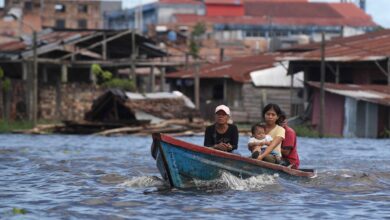Interview: Childhood Anxiety, How To Manage It?
During childhood, taking care of mental health is increasingly important. Anxiety is one of the most frequent diagnoses and it is essential that parents know how to prevent it.

Photo: Unsplash
LatinAmerican Post | María Fernanda Ramírez Ramos
Listen to this article
Leer en español: Entrevista: Ansiedad infantil ¿Cómo manejarla?
Anxiety in children is becoming more frequent and diagnosed. In recent years, and especially after the pandemic, the urgent need to pay more and more attention to mental health has become clear. The World Health Organization notes that depression, anxiety, and behavioral disorders are among the leading causes of illness and disability among adolescents.
"The pandemic has brought new worries, fears, unhappiness to the lives of children and adolescents and has highlighted the magnitude of the mental health problems suffered by children," says Save The Children. For this reason, in Latinamerican Post, we interviewed Ana María Reyes, a psychologist specializing in clinical psychology, child therapist, positive discipline trainer and one of the creators of "Firmeza y Afecto", to clarify doubts about childhood anxiety.
Latinamerican Post: Tell us a little more about anxiety in children. What is it and why does it manifest?
Ana María Reyes: We could say that anxiety is a response similar to fear, but it differs because while fear occurs in the face of a specific object or stimulus, such as clowns or an animal, anxiety is a more generalized response. In other words, it occurs more permanently, due to the convergence of different genetic and environmental factors.
Genetics are related to heredity and family history; if there are traits of anxiety in the parents or during pregnancy. In the environmental ones, we find situations that mark the child's childhood in some way, such as traumatic events that trigger anxiety. There are also environmental factors such as upbringing. This ends up being a combination of situations that add to the child's own temperament and neurodevelopment, which can also play a predisposing factor.
LP: Identifying and recognizing warning symptoms is essential for parents and caregivers. What are the most common symptoms of anxiety in children?
AR: Regarding the symptoms or indicators, the first thing is to be attentive to changes of prolonged duration, from 3 to 6 months approximately. For example, a decline in the child's social, school, or academic functioning and significant changes in eating, sleeping, or playing patterns. Sometimes, there are even some somatic symptoms such as pain or discomfort that do not seem to have an apparent clinical cause. There may also be manifestations of crying, irritability, fear, nightmares or fear of sleeping alone.
We recommend you read: Gallery: Family Day: These are the Paternity and Maternity Leaves in Latin America
LP: According to a report on mental health in children and adolescents from the Colombian Ministry of Health, anxiety includes a wide spectrum of diagnoses. Among them, the most common is separation anxiety disorder. What is it about?
AR: It is a very common type of anxiety and almost typical of development, which usually appears between 7 months and 6 years. It consists of anguish on the part of the child when he distances himself from the attachment figures, such as the mother, the grandparents, the father, the nanny… Then, faced with the separation, he begins to have the symptoms that we mentioned. It is quite common, especially when you start school. Then, this anticipatory anxiety begins to appear when the moment of separation from the parents approaches, for example before going to school.
To manage it, it is important not to fall into either of the two poles: neither remove the child completely from the situation that generates anxiety, but neither force him, or show little understanding or empathy in the face of his fear. On the contrary, you have to validate the emotion, welcome it, and something like paraphrase it. I mean, put it into words.
It is about accompanying and comforting the child in this anxiety, as far as possible progressively helping him to face the separation and developing anticipatory measures that allow him to face it. For example, having a transitional object, which is giving him an object that belongs to the mother (or the attachment figure), a doll, a blanket that belongs to him and is taken to preschool as a strategy to help him calm down. We don't take him out or avoid the distressing situation, but we don't get into situations where we tell him not to cry because of that, you have to put up with it, force him or not validate his emotion.
LP: How is it possible to prevent, from childhood, the appearance of anxiety? What should parents do?
AR: At a preventive level, it is very important to avoid parenting styles that are too rigid and authoritarian, which end up being a source of anxiety due to fear of punishment, scolding and not meeting parents' expectations or too strong reactions from adults. Or just the opposite: overprotection, with a tendency to see them helpless or incapable, so we do everything to them, we are scared all the time thinking that they are going to fall, they are going to hurt themselves, etc. and we transmit that feeling of fear. Or negligence, in which the child is neglected and left to his own devices, he is allowed to cry a lot or is not accompanied. This also generates in the child a feeling of abandonment, loneliness and, therefore, anxiety.
LP: How can a child with anxiety be helped to have the skills and abilities to manage emotions?
AR: When children are anxious it is ideal to help them identify their emotions and the body's reactions to those emotions. So, you have to allow him to read himself and identify: "when I'm anxious I move my legs, I bite my nails, I feel a sickness in my stomach, I turn red, etc." Learn to identify those symptoms, and to understand what is happening during a moment of anxiety.
Then, it is important that they learn self-regulation strategies that allow them to cope: moving away for a while, breathing, being quiet, drinking water, splashing water on their face. It is about helping them develop strategies so that they can regulate their emotions. For this, it is also essential that they learn to identify what is happening and anticipate it. For example, if they are arriving at a place where there are new or unknown people, we ask how you are going to greet them. "Suddenly you don't like to greet one by one, but then you can wave to everyone," tell them. Learn to react in advance to those situations that generate tension, anxiety or stress




